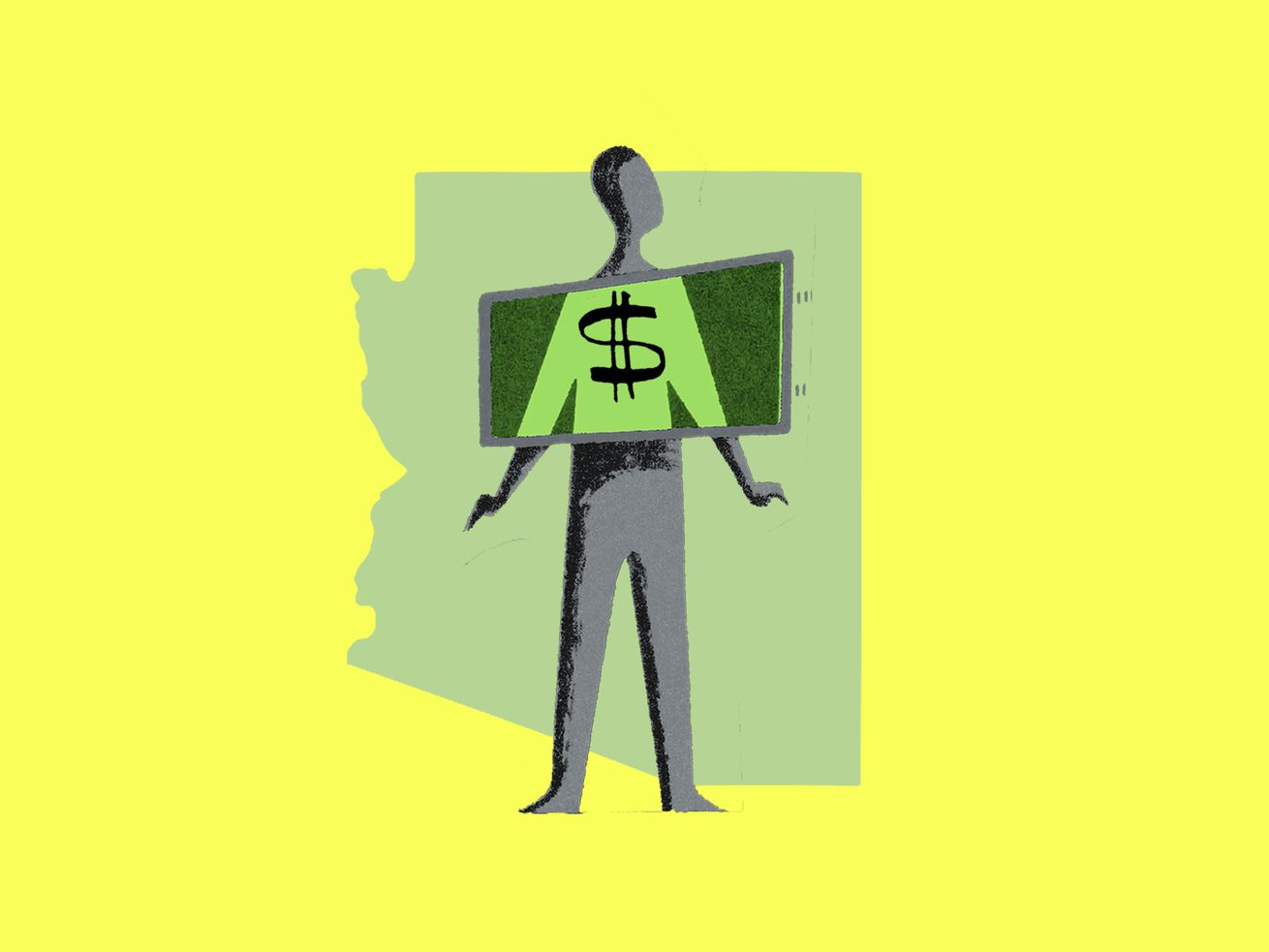Is going straight to voters the way to fix America’s medical debt crisis?
Pervasive medical debt is one of the US health system’s signature failings. About 4 in 10 Americans have debt resulting from their medical or dental expenses, according to recent estimates. Attempts to reduce the burden of medical debt have been halting, with special interests mucking up the legislative machinery both in Congress and in statehouses across the country.
That stasis makes a ballot initiative coming up for a vote next month in Arizona worth watching closely. Arizona Proposition 209 would put a cap on the interest rates that can be charged for medical debt: 3 percent. It would also limit debt collectors’ ability to seize a person’s house, belongings, automobile, or wages if they owe money for medical services by exempting more of a household’s assets from forfeiture or garnishment.
The policy itself shares key provisions with model legislation produced by the National Consumer Law Center and addresses some of the crueler debt collection practices, which policy experts say should help to relieve the burden of medical debt, particularly for people who have been taken to court by their debtors and face wage garnishment or the possibility of their house or car being possessed.
“For those people in the most desperate circumstances, this rule change is going to make the process a little bit less cruel for them,” said Joe Gerald, a health services researcher at the University of Arizona.
What’s equally interesting is the manner in which these proposals may become law. Through the work of Healthcare Rising Arizona, which drafted the ballot initiative and collected signatures to put it on the ballot, voters will get the chance to decide directly whether to put these new consumer protections in place. In a state currently governed by a Republican legislature that is largely sympathetic to the business community, the prospects for legislation like this have been dim, Gerald said.
According to the Medical Debt Policy Scorecard, a project that evaluated states’ laws for protecting their residents from medical debt, Arizona rated as “poor,” 32nd out of the 50 states. In 2015, the most recent state-level numbers available, the state had a slightly higher share of adults under 65 reporting medical debt than the national average. Advocates had to overcome an attempt to block the initiative from getting on the ballot in the first place — and more legal challenges may still await if it ends up passing — but for now, they are cautiously optimistic about enshrining new protections when voters go to the polls in November.
“The fact is when you have a less-government approach in a poor state, people get run over by businesses all the time,” Rodd McLeod, a Democratic political operative who is advising the campaign, said. “This will be a way we can have an effect on the number of families who are stuck with medical debt.”
National groups that focus on medical debt issues are watching the Arizona initiative closely. It is undeniably in the weeds — fixed interest rates and rules governing wage garnishment are not exactly bumper sticker material — and yet if even these proposals succeed at the ballot box, it could open up a new avenue for tackling medical debt outside of the conventional legislative process.
“Would it be easier to get medical debt provisions passed by the ballot initiative?” said Berneta Haynes, staff attorney at the National Consumer Law Center. “Starting out with something very weedy like this, if it has success, does that mean we could have success with simpler ballot measures?”
Medical debt is a burden for tens of millions of Americans
There is a lot to be done. Estimates of the number of Americans with medical debt vary considerably, but recent figures from the Kaiser Family Foundation put the number at 41 percent of all US adults. One in 10 adults owed more than $5,000 for medical or dental services. The people who carry medical debt tend to have lower incomes, poorer health, and higher rates of disability, and they are more likely to be Black. Medical debt negatively affects mental and physical health, too, due to stress and people skipping care for fear of the cost.
/cdn.vox-cdn.com/uploads/chorus_asset/file/24124610/1four_in_ten_adults_currently_have_debt_due_to_medical_or_dental_bills.png)
Kaiser Family Foundation
While there have been incremental efforts to expand health coverage (the Affordable Care Act) and restrict predatory hospital billing practices (the No Surprises Act) at the federal level, huge holes in the US health system’s safety net remain. Recent reporting by the New York Times laid bare the lengths to which hospitals are still willing to go to try to force patients to pay for care, even if they may qualify for free services, and to collect on those payments if they are past due.
States have been more active — North Carolina has been considering a medical debt reform bill, and legislation has passed in Colorado in recent months — but progress can be difficult. For example, a bill in New York that would have prohibited collectors from putting liens on homes or from wage garnishment stalled out this year, though advocates hope it will be revived in 2023.
Even with more recent action, the Medical Debt Policy Scorecard classified only three states as having “good” consumer protections from medical debt. The rest were either weak or poor; Arizona falls into the latter category, though the reforms being put before voters could improve its standing.
The campaign has relied on testimonials from Arizonans who have been saddled with medical debt, people like Liz Gorski, who has volunteered to collect signatures and stump for Proposition 209. Gorski was in a car accident at age 15 that put her in a coma and has left her with long-term care needs. She is 33 now and still sees a pulmonologist about once every three months. She also will see a neurologist every couple of months.
Gorski estimates that, over the years, she has accrued up to $50,000 in debt, a combination of her initial hospitalization and struggles to pay for her care in the years since. She has tried to make medical decisions that she feels are best for her — such as going to nerve therapy instead of taking pain medication for chronic pain — but her insurance does not always cover those services, adding to her personal cost.
The debt that was left on her record after her initial stay at the hospital made it harder for her to buy a car or a house as an adult; she says that without Habitat for Humanity, she may have ended up homeless. So when she saw an ad for Proposition 209, she reached out to the organizers and asked how she could help.
“We were all just teenagers. None of us would have been prepared for that,” Gorski said. She has supported the ballot measure “because of my own journey and what me and my friends went through and how it destroyed us.”
The Arizona initiative is meant to help people who are in a situation like Gorski’s, where they have already incurred a lot of medical debt and are trying to minimize the consequences. According to Gabriela Elizondo-Craig, a postgraduate fellow at the University of Arizona who led the scorecard project, the policy experts they interviewed cited improving the experience for people going through the legal process without a lawyer and reducing the consequences for people after court as the most consequential actions that a state could take. Policies that prevent people from accruing medical debt in the first place — expanded coverage, more financial assistance, presumptive eligibility for health coverage, etc. — are another option for policymakers.
According to Elizondo-Craig, 26 states have rules around wage garnishment or property seizure, but just 14 states cap interest rates for medical debt, as the Arizona ballot measure would.
“These policies do focus on people in the most extreme circumstances, but they are also the most in need of protection,” she said.
It is also possible, Gerald said, that a more stringent policy landscape for debt collectors could more generally make them less aggressive — a kind of beneficial chilling effect. That is speculative for now, but Elizondo-Craig said that, anecdotally, she has heard from people who work in hospital debt collection that the bigger the administrative burden on providers or collectors, the less likely they will be to pursue outstanding debts.
The problem isn’t going away, but legislative progress has been halting. Arizona will be a test case: Are voters willing to intervene to relieve the burden of medical debt if lawmakers are not?
“I think we’re going to continue to see an uptick in activity,” Eva Stahl, vice president of public policy at RIP Medical Debt, said, “given the frustration of not being able to address it at the federal level.”
Author: Dylan Scott
Read More



